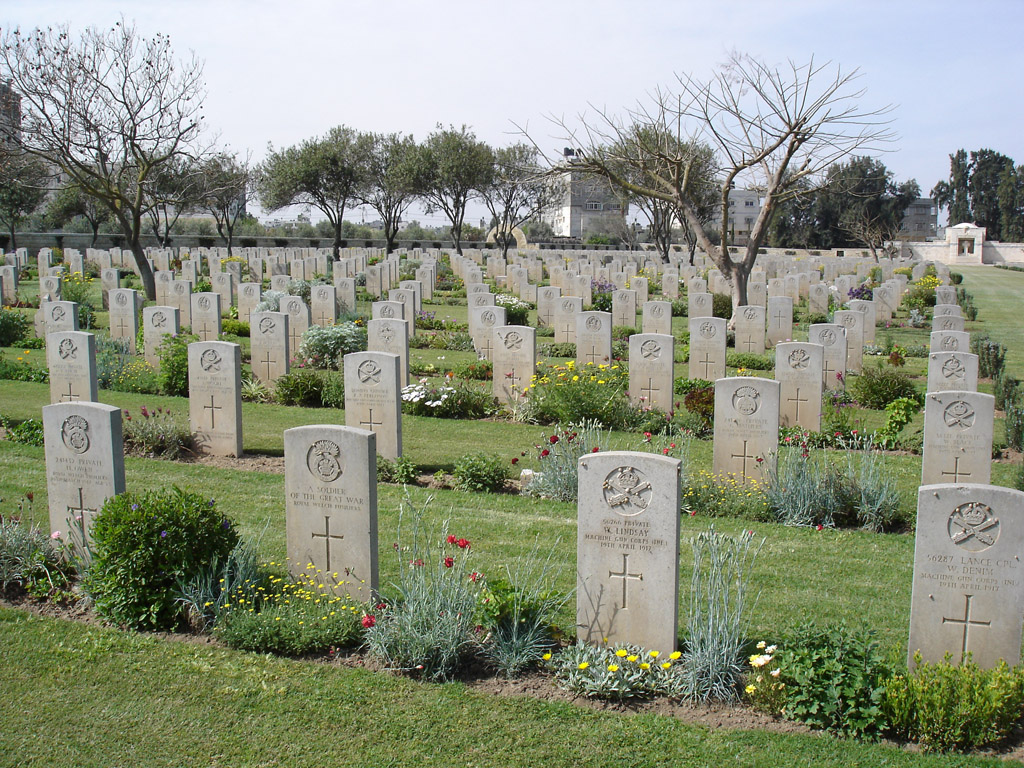Gaza War Cemetery
- Country Israel and Palestine (including Gaza)
- Total identified casualties 2696 Find these casualties
- Identified casualties from First & Second World War
- GPS Coordinates Latitude: 31.51247, Longitude: 34.4821
Historical Note
 Casualties within the Indian section of this cemetery were originally commemorated by a nameless memorial with their names added to a cemetery register. In 2000, their names were added to the memorial.
Casualties within the Indian section of this cemetery were originally commemorated by a nameless memorial with their names added to a cemetery register. In 2000, their names were added to the memorial.
You can find more information about historical inequalities in commemoration in our Special Committee’s report.
PLEASE NOTE
November 2023 – This cemetery is currently closed to visitors.
Location information
Gaza is 3 kilometres inland from the Mediterranean coast, 65 kilometres south-west of Tel Aviv. Gaza can be accessed from Israel via the Erez Crossing point. Gaza War Cemetery is 1.5 kilometres north-east of the city near the Bureir Road and 370 metres from the railway station. The Cemetery is approximately 8 kilometres to the left of the main dual carriageway, Highway 250 through Gaza, and is about 200 metres back from the road through an avenue of trees. Alternatively, turn left off the highway after 4 kilometres, continuing with Highway 4 until Sha'arei Aza junction and turn right, then turn right into Gaza proper, heading back towards the border. In this direction the cemetery will be found on the right hand side after approximately 3 kilometres.
Visiting information
The cemetery is open every day from Saturday to Wednesday from 7.00am to 3.00pm
Visitors are strongly advised to seek travel advice from their Embassy or Consulate before travelling to Gaza.
Wheelchair access possible via main entrance. For further information and enquiries please contact enquiries@cwgc.org
History information
Gaza was bombarded by French warships in April 1915. At the end of March 1917, it was attacked and surrounded by the Egyptian Expeditionary Force in the First Battle of Gaza, but the attack was broken off when Turkish reinforcements appeared. The Second Battle of Gaza, 17-19 April, left the Turkish forces in possession and the Third Battle of Gaza, begun on 27 October, ended with the capture of the ruined and deserted city on 7 November 1917. Casualty Clearing Stations arrived later that month and General and Stationary hospitals in 1918.
Some of the earliest burials were made by the troops that captured the city. About two-thirds of the total were brought into the cemetery from the battlefields after the Armistice. The remainder were made by medical units after the Third Battle of Gaza, or, in some cases, represent reburials from the battlefields by the troops who captured the city. Of the British Soldiers, the great majority belong to the 52nd (Lowland), the 53rd (Welsh), the 54th (East Anglian) and the 74th (Yeomanry) Divisions.
During the Second World War, Gaza was an Australian hospital base, and the AIF Headquarters were posted there. Among the military hospitals in Gaza were 2/1st Australian General Hospital, 2/6th Australian General Hospital, 8th Australian Special Hospital, and from July 1943 until May 1945, 91 British General Hospital. There was a Royal Air Force aerodrome at Gaza, which was considerably developed from 1941 onwards.
Gaza War Cemetery contains 3,217 Commonwealth burials of the First World War, 781 of them unidentified. Second World War burials number 210. There are also 30 post war burials and 234 war graves of other nationalities.



